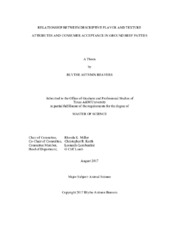| dc.description.abstract | Ground beef is one of the most widely consumed beef commodities; emerging trends in the industry are utilizing different formulations and grind treatments to affect flavor and texture attributes in ground beef patties. In this study, sixteen treatments were utilized, including four meat sources (chuck, regular, sirloin, round), two fat percentages
(10 and 20%), and two grind treatments (6.4 mm grind and bowl- chopped) to better understand trained descriptive beef flavor and texture attributes, volatile flavor aroma compounds, and consumer attitudes and preferences in ground beef. Meat sources arrived as subprimals and were trimmed of all external fat before formulating. Patties were formed with a patty maker using a 2.54 cm mold.
Meat source by fat interactions were significant for beef identity, brown, roasted, bloody/serumy, umami, salty, and particle size (P < 0.05). Bowl-chopped patties were higher in hardness, and springiness scores compared to 6.4 mm ground patties, while 6.4 mm ground patties were higher in umami and particle size (P < 0.05) compared to bowl-chopped patties. Meat source affected bitter, cardboard, fat-like, liver-like, sour, sour milk/sour dairy, hardness, and springiness flavor and texture attributes (P < 0.05).
Consumers (n = 314) from four cities across the United States liked ground beef patties ground to a 6.4 mm grind size better than bowl-chopped patties for all attributes (P < 0.05). Flavor liking and texture liking were impacted by meat source, while only texture liking was impacted by fat level (P < 0.05). A grind by fat interaction existed for overall cooked appearance liking, overall liking, and flavor liking, while a meat source by fat interaction only existed for flavor liking among consumers.
Volatile aromatic compounds were most impacted by grind treatment. 2,5- dimethyl-pyrazine, 3-ethyl-2,5-dimethyl-pyrazine, trimethyl-pyrazine, 2-ethyl-5-methylpyrazine, and 2-ethyl-6-methyl-pyrazine were all higher in ground beef patties ground to a 6.4 mm grind size (P <0.05) compared to bowl-chopped patties. A meat source by grind interaction existed only for hexanal, and a grind by fat interaction existed only for acetic acid and 2-ethyl-3,5-dimethyl-pyrazine. Flavor and consumer acceptability of ground beef can be improved by optimizing grind, lean source, and fat level. | en |


